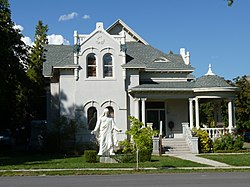
Maeser Elementary was an elementary school in Provo, Utah. It was named after Karl G. Maeser. Built in 1898, it is the oldest school building in Provo, Utah. The school was designed by architect Richard C. Watkins, who also designed the Provo Third Ward Chapel and Amusement Hall, The Knight Block Building, and the Thomas N. Taylor Mansion.

The Knight–Mangum House is a historic house located in Provo, Utah, United States. It is listed on the National Register of Historic Places. The mansion was built in the old English Tudor style, completed in 1908. It was built for Mr. W. Lester Mangum and his wife Jennie Knight Mangum. Mrs. Mangum was the daughter of the famous Utah mining man, Jesse Knight. The lot was purchased for $3,500 and the home was built at a cost of about $40,000. The Mangum family was able to afford the home due to the fact that they had sold their shares in Jesse Knight's mine located in Tintic, Utah, for eight dollars a share. They had purchased the shares for only twenty cents a share, so the excess allowed them enough funds to purchase the home. The contractors for the home were the Alexandis Brothers of Provo.
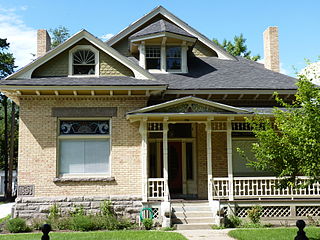
The Charles E. Loose House is a historic house located in Provo, Utah, United States. The house was individually nominated for listing on the National Register of Historic Places in 1982 but was not listed due to owner objection. It later was included as a contributing property in the Provo East Central Historic District.

The Samuel H. Allen Home is a historic house located at 135 E. 200 North in Provo, Utah. It is listed on the National Register of Historic Places.
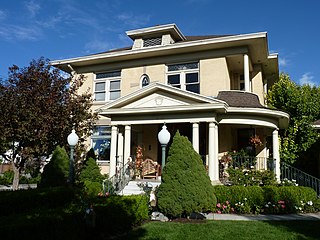
The Thomas N. Taylor House is a historic house located at 342 North 500 West in Provo, Utah. It is listed on the National Register of Historic Places.

The John E. Booth House is a historic house located in Provo, Utah. John E. Booth was a significant Provoan, and was extensively involved in Provo's community and religious affairs. Located at 59 West and 500 North and less than one acre in size, the John E. Booth House was built in 1900, and happens to be the only 2+1⁄2-story Victorian Mansion in Provo, Utah. This house is significant not only as a Victorian mansion, but because its "Bricks were individually painted to create a variegrated design effect". The house was added to the National Register of Historic Places in 1982. The house was designated to the Provo City Historic Landmark Register on May 26, 1995.

The William H. Ray House is a historic house located at 415 South University Avenue in Provo, Utah. A prominent non-Mormon in Provo, Utah, William H. Ray was one of the founders of the State Bank of Provo. A financier, banker, and broker, Ray organized the Ray Investment Company as an insurance and real estate brokerage firm. The William Ray House, which was built around 1898, "Combines Romanesque Revival elements with classical detailing in a personalized manner ." The William H. Ray House was added to the National Register of Historic Places in 1982 and was designated to the Provo City Historic Landmark Register on April 28, 1995. It is currently divided into apartments.
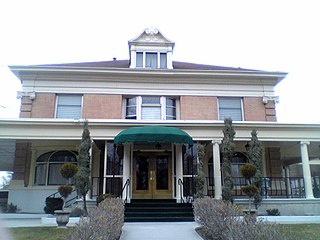
The Jesse Knight House, also known as the Knight Mansion, is a historic house in Provo, Utah, United States built for Jesse Knight. It was built in 1905, and added to the National Register of Historic Places in 1982. This home was designated to the Provo City Historic Landmarks Register on June 19, 1996.

The Hines Mansion is a historic house in Provo, Utah, United States. It is listed on the National Register of Historic Places. It was built in 1895 for R. Spencer Hines and his wife Kitty. At the time the mansion was built, it was recognized as one of the finest homes in Provo. The Hines Mansion was designated to the Provo City Historic Landmarks Registry on March 7, 1996.

The George M. Brown House is a historic residence in Provo, Utah, United States, that is listed on the National Register of Historic Places. It was built as a home for a "polygamous wife" of lawyer George M. Brown. It is listed on the National Register of Historic Places.

The Charles E. Davies House is a historic house located in Provo, Utah. It is listed on the National Register of Historic Places. It is currently a private residence.

The Knight–Allen House is a historic house located in Provo, Utah. It is listed on the National Register of Historic Places.

The Knight Block is a historic building located on South University Avenue in downtown Provo, Utah, United States. It is listed on the National Register of Historic Places.

The Provo Downtown Historic District is a 25-acre (10 ha) historic area located in Provo, Utah, United States. It is listed on the National Register of Historic Places.
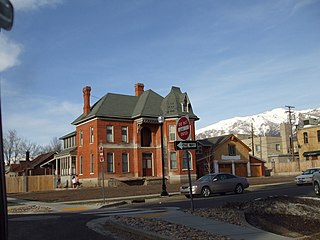
The John George Moroni Barnes House is a historic residence in Kaysville, Utah, United States, that is listed on the National Register of Historic Places (NRHP).
The Beck No. 2 Mine near Eureka, Utah dates from 1890. It was listed on the National Register of Historic Places in 1979. The listing included "surface plant buildings" of the lead mine and one other contributing structure, a "remaining wooden headframe", described as a "fifty foot wooden headframe A-frame Montana type". These evoke the past mining operations at the site.
The Charcoal Kilns near Eureka, Utah were listed on the National Register of Historic Places in 1979. The listing included two charcoal kilns that each are about six feet in diameter and four feet deep, built out of stone. They are believed to have been built or used to support the Wyoming Smelter in 1871.
The Lime Kilns located at the western end of Homansville Canyon near Eureka, Utah, were part of a lime quarry in the 1920s. The kilns were listed on the National Register of Historic Places in 1979. The listing included one contributing site and two contributing structures: two lime kilns that are approximately 8 feet (2.4 m) in diameter and 30 to 40 feet deep.
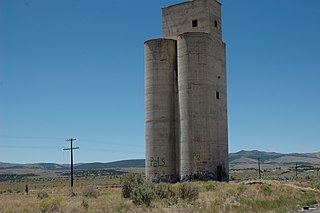
The Knight Grain Elevator is a historic grain elevator along Utah State Route 36 in the former community of Knight, Utah, United States, that is listed on the National Register of Historic Places (NRHP). The elevator is nearly all the remains of Knight, which is located in the Tintic Valley, about 4 miles (6.4 km) west of the city of Eureka in eastern Juab County.

The Tintic Smelter Site, located off U.S. Route 6 near Silver City, Utah, United States, that is listed on the National Register of Historic Places (NRHP).
